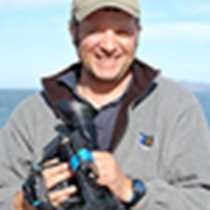The last day of our expedition took us to San Cristobal, or Chatam Island, the first island visited by Charles Darwin during the voyage of the Beagle in September 1835.
We took our last hike at the northeastern end of this large island at a site named Punta Pitt, an old tuff cone with impressive cliffs. The hike follows along a dry stream bed, and once you reach the plateau covered with patches of red Sesuvium the view is fantastic. The trail offers one the most dramatic landscapes around the Galapagos and it’s one of the few places in the Galapagos where you can see a colony of red-footed boobies nesting. These boobies are the only ones among the three species found in Galapagos that nest in trees and bushes along the cliffs. Today we had the opportunity to find some close enough to the trail, and some of them on their nests with chicks and eggs.
Once we finished our beautiful yet demanding hike, it was time to enjoy the beach and the playful sea lions. Our young explorers had a blast playing with them and at the end we were unsure of who was having a better time, the sea lions or the kids.
After lunch, we'll sail towards the imposing offshore islet named Leon Dormido, or Kicker Rock in English, an old rocky outcrop that is the remainder of a volcanic tuff cone eroded by the wind and wave action. The water was choppy and full of jellies, but despite that, our adventurous guests were able to enjoy some interesting snorkelling among colorful schools of fish, spotted eagle rays, sea turtles, and some white and black-tipped sharks.
Once all of us were back on board, we enjoyed circumnavigating this unique formation with drinks on deck, before traveling to our final destination, the town of Puerto Baquerizo Moreno, home to some 9,000 inhabitants and the political capital of the Ecuadorian province of Galapagos.
After dinner, our guests were able to walk in town and experience a little bit the Galapagos life. There were kids riding bikes or playing among sea lions found laying on the streets or benches, visitors of different nationalities walking, shopping, or eating at the local restaurants, and locals drinking a beer or chatting here and there.
This is Galapagos, a unique place where humans and nature coexists in harmony.









